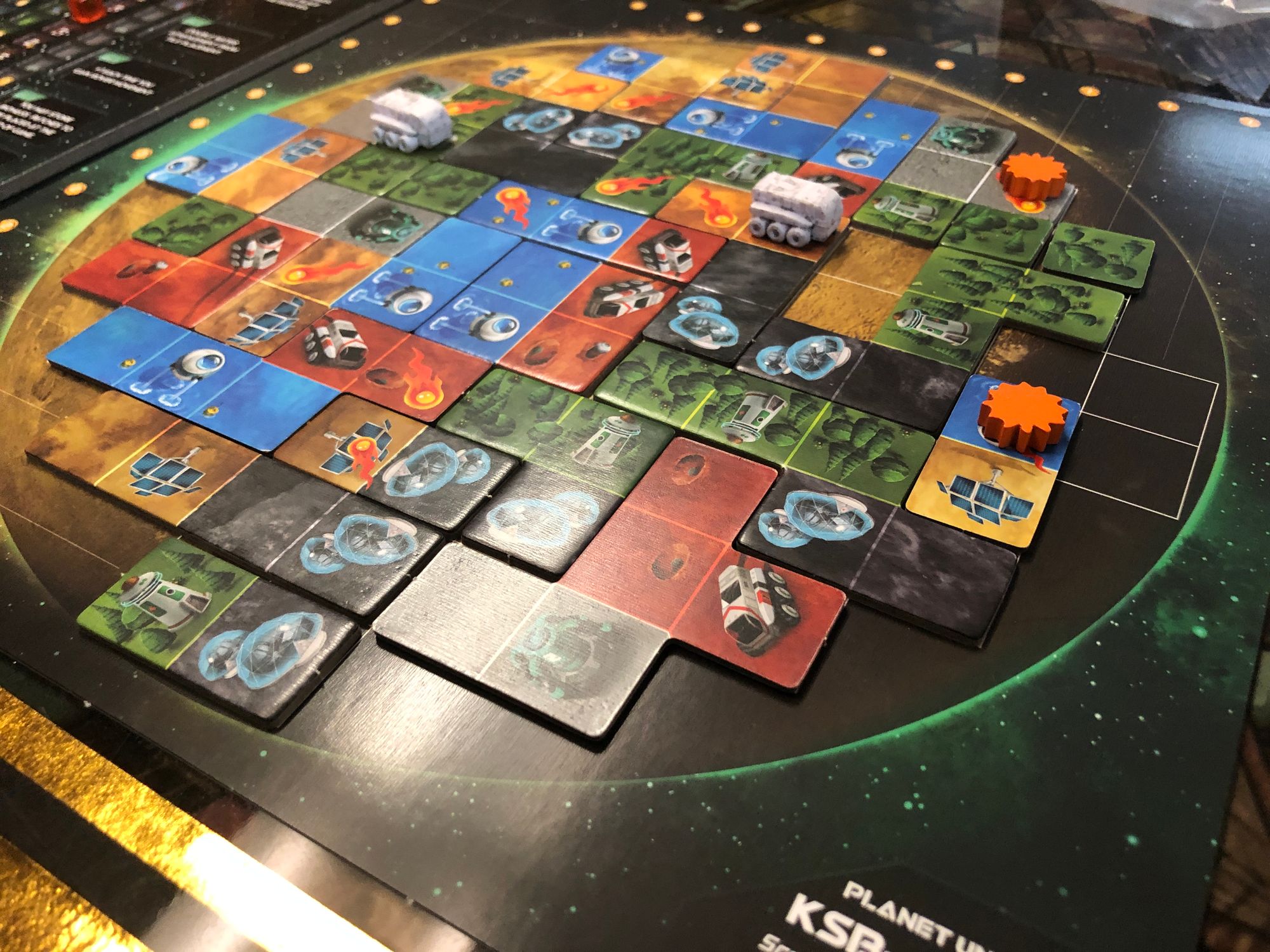I’ve been waiting for a game to come along that fits the same purpose as 7 Wonders: High player count with excellent time scaling, some kind of engine building mechanism, a relatively light teach, and a lot of replayability. While theme and gameplay of Planet Unknown is very different from 7 Wonders, it really fills that niche well. With a player count of six, simultaneous actions, tile drafting, and a light tech tree, Planet Unknown is a really fantastic game to have on your shelf.
To start, give everyone a player board showing the image of a planet with a grid laid over it and a Progress Tracker sideboard. Each player gets two Rovers, 5 colored cubes to track progress, 6 Life Pods to place on their Planet Boards, and a couple of colored chits to denote player color and pull location on the Lazy Susan (I’ll get to that in a minute). Then, shuffle and deal one Objective Card between each player. Objective Cards between two players are shared between you and the player next to you. Shuffle and create a deck of Civic Advancement cards for each of four Civ levels and place the Lazy Susan in the middle of the table. Each player then places one of their colored chits around the Lazy Susan pointing to one of its six tile bays. Decide who gets to be the Space Commander (SC) — the first player, which will rotate throughout the game — and begin play.

The Lazy Susan is split up into six wedges, and each of those wedges holds two stacks of polyomino tiles. When a turn begins, the SC rotates the Lazy Susan so that the wedge they want to choose from lines up with their colored player chit. Each player then chooses one tile from the wedge aligned with their colored player chit and places it on their Planet Board. Placement of this tile must either be along the edge of the planet grid or orthogonally adjacent to a tile previously placed (if you’ve ever played something like Patchwork or Barenpark, you’ll be used to the spatial awareness required). If the tile has a Meteor icon on it, place a Meteor token onto that icon once the tile is placed. Each player then advances their Progress Trackers one step for each track represented on the tile placed (each tile has two different progress types denoted by that progress type’s color and icon).
There are six progress types:
- Civ allows you to draw cards from the Civilization decks as you progress.
- Water doesn’t do much by itself but will score the most bonus points at the end of the game.
- The Biomass track generates 1x1 tiles to fill gaps on your planet grid.
- Rover allows you to add and move your Rovers around your grid to pick up Meteors.
- Tech lets you modify the rules in your favor as you advance along it.
- Energy doesn’t have a progress track of its own, but instead acts as a wildcard, allowing a player to advance any Track adjacent to the Energy region of the tile placed.
All tracks award bonus points at the end of the game, and also have little colored circles that immediately let a player advance any Track an additional time.
Once all players have placed their tiles, the SC badge rotates to the next player clockwise, they rotate the Lazy Susan, tiles are placed, etc. This continues until someone can’t place a tile onto their board. When that happens, total the points from completed rows and columns on your Planet Board (ignoring any rows or columns with a meteor), Progress Tracks, Civ cards, Life Pods, Objectives, and any other scoring value. Whoever has the most points, wins!
The components of Planet Unknown are great. The tiles are good-quality chipboard, cards are pretty standard, Planet Boards are thin stock (but double-sided for additional variety). The Progress Tracks sideboards are double-cut, so the little tracker cubes won’t slip around due to clumsy fingers. Rovers, Meteors, and Life Pods are meeples/models instead of chipboard tokens, so they provide a nice contrast to the look of a player’s board as it’s being completed. The Lazy Susan is really the star here; it’s really well designed, integral to game play, and acts as storage for all of the polyominoes, so setup and teardown is pretty quick.
Planet Unknown is really just a great game. Because it’s largely solitaire/simultaneous action-based, it plays well at all player counts and is only slightly longer with more people at the table. It takes about five minutes to teach the purpose and structure of a turn, but rewards return play. Having double-sided Planet Grids and Progress Trackers (both of which add unique constraints and rewards) adds a bunch of replayability and creates a very easily reproduced method of expansion. If you can find a copy, grab it.
Designed by: Ryan Lambert, Adam Rehberg
Player Count: 1-6
Playtime: 60-90 minutes
Time to Learn: 10 minutes
Complexity: 2.5/5
Replayability: 5/5
MSRP: $60
Brendan Quinn is the President of Tri-City Area Gaming: a nonprofit dedicated to making games inclusive and accessible to everyone. Come play games with us at any of our regular monthly events: tricityareagaming.org/calendar
We’re also on Discord: discord.gg/gAgZzYz


